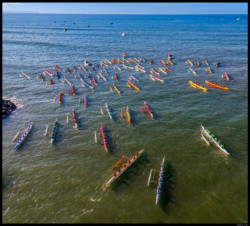Welcoming Back the Molokai Hoe
 Early on Sunday, Oct. 13, Molokai residents gathered at Hale O Lono to witness the start of the Molokai Hoe for the first time since 2019. Seventy-five crews from Hawaii, Tahiti, Japan, California and more, turned their wa’a west, dug in their paddles, and embarked on a 41-mile journey across the Ka’iwi Channel. This year, representing Molokai was a crew from Wa’akapaemua Canoe Club, along with Molokai athletes also paddling with Waikiki Surf Club and Wailea Canoe Club.
Early on Sunday, Oct. 13, Molokai residents gathered at Hale O Lono to witness the start of the Molokai Hoe for the first time since 2019. Seventy-five crews from Hawaii, Tahiti, Japan, California and more, turned their wa’a west, dug in their paddles, and embarked on a 41-mile journey across the Ka’iwi Channel. This year, representing Molokai was a crew from Wa’akapaemua Canoe Club, along with Molokai athletes also paddling with Waikiki Surf Club and Wailea Canoe Club.
“This race is special,” said Wa’akapaemua’s Kamakou Mariano, who sits in the stroke seat. On the eve of his seventh channel crossing, Mariano took a moment to reflect on the paddling season, which culminates with the Molokai Hoe.
“I think we’re in good shape,” he said. “I feel great. The body feels good. I feel ready for it.”
The days leading up to the race were a combination of perfecting last-minute training and juggling logistics. Each crew needed an escort boat along with provisions, extra equipment and manpower to support their channel crossing efforts.
The Wa’akapaemua crew started coming together about six months ago, training up to five days a week in the canoe along with strength and conditioning workouts. The Molokai crew, comprised of Mariano, Troy Heen, Lohiao Paoa, Namaka Ross, Kui Han, Kepa Albino, Noah Keanini, Kahale Naehu-Ramos and Makena Fernandez, was a combination of youth and experience.
With only four of the crew having completed the race before, they leaned on their fitness to make up the gap in race familiarity, explained Mariano.
“The training that we’ve put in is going to make up for the lack of experience,” he said. “The new guys are really hungry to do it…It gave us guys who did it a lot of times before more motivation.”
In addition to long paddles from Honouliwai, Puko’o and Kamalo, the crew dedicated one day per week to a brutal combination of hill sprints in Kawela.
“I think this is one of our better years in training,” said Heen.
The race itself was a relatively calm day, with moderate winds and swells perfect for pushing the pace. Shell Va’a from Tahiti took the win with a blazing time of 4:35. Wailea Canoe Club, with Molokai paddlers Kevin and Dane Dudoit, earned second place, with Wa’akapemua coming in 17th place in their division.
One notable feature of this year’s race was the Waikiki Surf Club crew, with Molokai juniors Nykee Kekupukoa Naeole-Starkey, Kahikikala Helm, Kaehuiki Linker Meyers-Moss, and Chaystin Joao, becoming the youngest boat ever to complete the Hoe.
Before the race, on the shore of the Hale O Lono harbor, Meyers-Moss was looking forward to some well-earned rest and recovery over on Oahu.
“Just sleep, eat, surf,” he said.
In the race itself, the paddlers navigated along Molokai’s southern shore before breaking into the channel and heading for Diamond Head.
Although the race was well over five hours, “it went by really quick,” said Wa’akapaemua’s Naehu-Ramos.
For Naehu-Ramos, Sunday was his first time crossing the channel. While he was nervous hitting the water for the first crew change, once he got in the canoe it was business as usual.
Paddlers changed every 30 minutes, with steersman Fernandez staying in for the complete race.
“Having the experienced guys helped a lot,” Naehu-Ramos said, “and we had the muscle to pump through the flatter waters.”
For the first time in over 20 years, this year’s Na Wahine O Ke Kai and Molokai Hoe included both a women’s and men’s crew entirely comprised of Molokai athletes. The crews said their goal is continuing the momentum into the future.
“This is just a building year,” said Naehu-Ramos. “If we’re hosting the event, we got to represent.”
With the objective for next year to have two Molokai crews entered in the race, the relationships made from paddling and training together will be more important than ever.
It’s the communal bonds forged through long hours, early mornings, and hard-won workouts which ultimately keeps athletes engaged in the sport, explained Heen.
“It’s what keeps me happy,” said Heen. “I’m addicted. You could be having a bad day, you go paddle in the afternoon, do a Kamalo run, and everything is all good after that. You go home happy.”
“After a while [paddling] is just part of your life,” explained Mariano. “You keep doing it. It becomes an addiction. It keeps you healthy…My wife paddles and all my friends paddle.”
“The paddling community is tight,” said race organizer Ikaika Rogerson from the Oahu Hawaiian Canoe Racing Association (OHCRA). “It’s nice to come back home and to get to reconnect with people we haven’t seen for four years. It’s like being back home with family.”
Putting on the races after a four-year hiatus was a massive coordination effort between race organizers, Molokai families, and state representatives, which included working with the Dept. of Transportation to repair the road to Hale O Lono, explained Rogerson.
“We want to thank everyone here on the island of Molokai,” said Rogerson. OHCRA encouraged participants to donate paddling equipment to the Molokai Canoe Racing Association, as well as collected $10,000 from entry fees to donate to the Friends of Molokai High and Middle Schools Foundation.













Don't have a Molokai Dispatch ID?
Sign up is easy. Sign up now
You must login to post a comment.
Lost Password